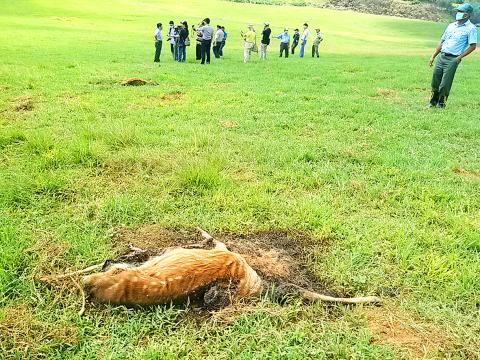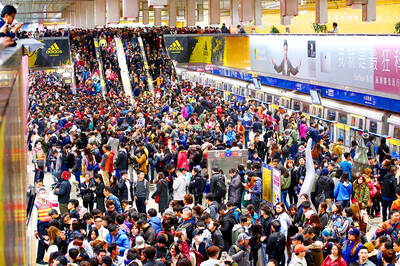The Kenting National Park Administration yesterday rejected reports that herds of Formosan sika deer had been slaughtered, but added that current laws are insufficient to protect the animals from poaching or mistreatment.
Reports yesterday claimed that more than 300 Formosan sika deer under the care of park administrators had been killed by humans and stray dogs, with their remains scattered across Longzaipu Meadow (籠仔埔) and Banana Bay (香蕉灣) in the park.
Park Deputy Director Lee Teng-chih (李登志) said the agency and local police inspected the sites immediately after hearing the reports, but found just nine dead deer on the meadow, which Lee attributed to an attack by stray dogs.

Photo: CNA
This is not the first time deer in the park have been attacked by strays, he said.
Referring to what were said to be the bones of deer packed into bags and discarded in the bay, Lee said that preliminary documentation by National Pingtung University of Science and Technology professor Pei Chia-chi (裴家驥) of some skulls found among the remains indicated that the bones belonged to pigs.
He added that pig farmers have disposed of pig bones in the bay for a long time.
Suspected illegal hunters found guilty of poaching in the national park would be fined NT$3,000 under the National Park Act (國家公園法), Lee said, adding that he thinks the fine is “very low.”
Lee said that the law has remained largely the same since it was introduced in the 1970s and that the penalties it stipulates are outdated.
He said that the administration wants to register the deer on the Forestry Bureau’s list of protected wildlife, which would give them better protection under the law, but the animals must pass a Council of Agriculture analysis of their DNA.
The species went extinct in the wild in the 1970s and was restored in about 1984, but some have suspected that the current herds are products of mixed breeding, which has prevented them from being recognized by the council, Lee said.
He added that his agency is gathering information to prove that the deer are pure-blooded.
He said that there are about 2,000 Formosan sika deer on the Hengchun Peninsula (恆春半島) and in the Jioupeng area (九棚) in Pingtung, but most are in captivity in a protected zone managed by the administration.
A prior placement project was unsuccessful, with all 233 deer released into the wild having died, Lee said.
Forestry Bureau Section Chief Kuan Li-hao (管立豪) said the failure of the placement project is the major reason preventing the deer from being recognized.
He said that the deer in the park, restored from Formosan sika deer at zoos, drew suspicion over their origins, with some saying that they could be the offspring of sika deer imported from abroad.
He said that he would love to see the deer put on the list, but urged the administration to cooperate with the bureau in providing a placement project assessment report and DNA documentation.

People can take the Taipei MRT free of charge if they access it at Nanjing Sanmin Station or Taipei Arena Station on the Green Line between 12am and 6am on Jan. 1, the Taipei Department of Transportation said on Friday, outlining its plans to ease crowding during New Year’s events in the capital. More than 200,000 people are expected to attend New Year’s Eve events in Taipei, with singer A-mei (張惠妹) performing at the Taipei Dome and the city government’s New Year’s Eve party at Taipei City Hall Plaza, the department said. As people have tended to use the MRT’s Blue or

Civil society groups yesterday protested outside the Legislative Yuan, decrying Chinese Nationalist Party (KMT) efforts to pass three major bills that they said would seriously harm Taiwan’s democracy, and called to oust KMT caucus whip Fu Kun-chi (傅?萁). It was the second night of the three-day “Bluebird wintertime action” protests in Taipei, with organizers announcing that 8,000 people attended. Organized by Taiwan Citizen Front, the Economic Democracy Union (EDU) and a coalition of civil groups, about 6,000 people began a demonstration in front of KMT party headquarters in Taipei on Wednesday, organizers said. For the third day, the organizers asked people to assemble

Taipei is participating in Osaka’s Festival of Lights this year, with a 3m-tall bubble tea light installation symbolizing Taiwan’s bubble tea culture. The installation is designed as a bubble tea cup and features illustrations of Taipei’s iconic landmarks, such as Taipei 101, the Red House and North Gate, as well as soup dumplings and the matchmaking deity the Old Man Under the Moon (月下老人), affectionately known as Yue Lao (月老). Taipei and Osaka have collaborated closely on tourism and culture since Taipei first participated in the festival in 2018, the Taipei City Department of Information and Tourism said. In February, Osaka represented

Taiwanese professional baseball should update sports stadiums and boost engagement to enhance fans’ experience, Chinese Professional Baseball League (CPBL) commissioner Tsai Chi-chang (蔡其昌) told the Liberty Times (sister paper of the Taipei Times) in an interview on Friday. The league has urged Farglory Group and the Taipei City Government to improve the Taipei Dome’s outdated equipment, including relatively rudimentary television and sound systems, and poor technology, he said. The Tokyo Dome has markedly better television and sound systems, despite being 30 years old, because its managers continually upgraded its equipment, Tsai said. In contrast, the Taipei Dome lacked even a room for referees